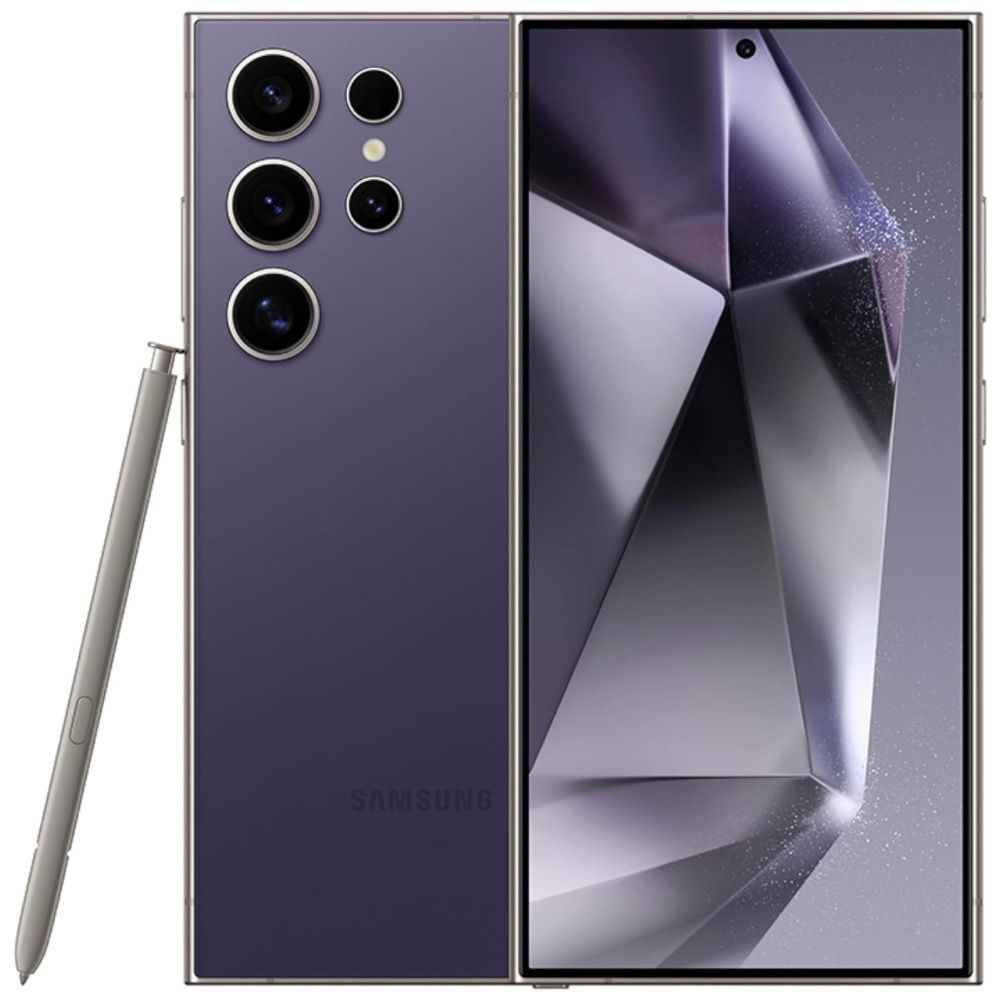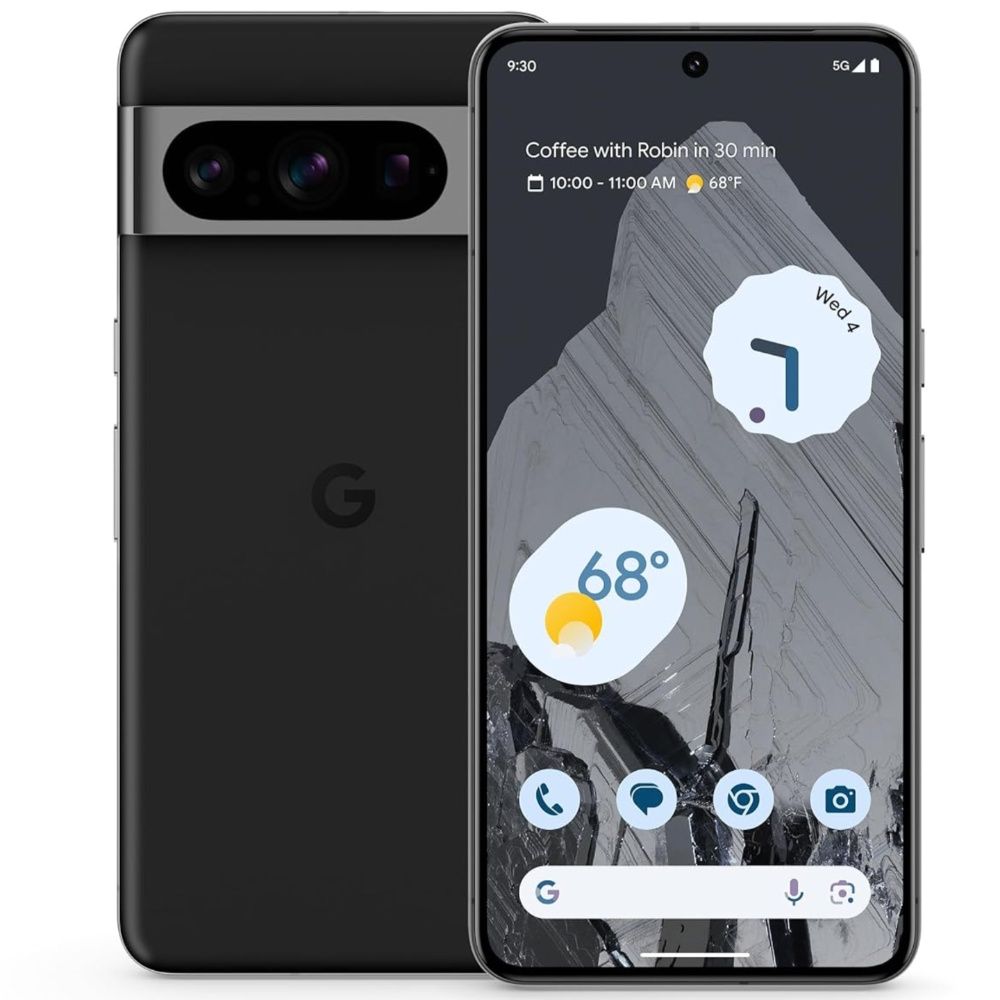-

Samsung Galaxy S24 Ultra
The Pinnacle of Power and Durability
The Samsung Galaxy S24 Ultra is a remarkable Android smartphone that showcases an array of advanced features. Launched in January 2024, it boasts a 6.8-inch display, powered by the Snapdragon 8 Gen 3 chipset. It is equipped with a robust 5000 mAh battery and offers a generous storage capacity of 1024 GB, alongside 12 GB of RAM. Its durability is enhanced with Corning Gorilla Armor, ensuring the device's resilience and longevity .
Pros- High performance
- Large storage capacity
- Durable design
- Powerful & lasting battery
Cons- Huge size with lots of weight
-

Google Pixel 8 Pro
Capturing Excellence, One Pixel at a Time
The Google Pixel 8 Pro, announced in October 2023, is a high-end Android smartphone that features a 6.7-inch display and is powered by the Google Tensor G3 chipset. It comes with a 5050 mAh battery, offering extended usage times, and has a storage capacity of up to 1024 GB with 12 GB of RAM. The device is protected by Corning Gorilla Glass Victus 2, ensuring both durability and premium quality.Pros- Advanced camera technology
- Google Tensor G3 chipset
- Long battery life
- Sturdy build quality
Cons- Limited customization
- Ecosystem integration is a must
The battle between Samsung and Pixel smartphones has been a long one. Both are great Android smartphones and can fulfill their user requirements to the teeth. They boast some of the best technology in the market and have been powered by tech giants with billions in revenue. Yet, this competition lies at a standstill, with no clear winner, necessitating a more nuanced comparison. Because while their hardware is similar, it's not identical, and in this day and age, raw specifications hardly matter.
What does matter is the kind of experience they offer their users, along with minute optimizations. If a user can't utilize their smartphone for its intended use, then the brand isn't for them, no matter how much hardware and features are crammed into it. Despite this, the competition is stiff, with the victor decided by the most mundane factors.
Technical Details
Samsung's Galaxy series has always represented the pinnacle of the company's technological advancements in the mobile smartphone space, featuring cutting-edge processors, expansive and high-resolution displays, and innovative camera technologies, aiming to build and provide an ecosystem for its users. The brand's primary focus is on providing a device that's both premium and powerful and can fulfill a wide range of consumer needs.
In contrast, Google, also the owner of Android (one of the two dominant operating systems), focuses its efforts on software excellence and camera capabilities. It emphasizes the idea that performance-wise, technology has long surpassed its intended goals, and thus, there's a growing need to make the most of what they have. Leveraging Google's prowess in machine learning and artificial intelligence, Pixel phones offer a plethora of Quality of Life (QoL) features like Night Sight and Call Screen, with constant performance and feature updates.
Samsung Galaxy S24 Ultra Google Pixel 8 Pro Brand Samsung Google SoC Snapdragon 8 Gen3 Tensor G3 Display 6.8-inch 6.7-inch RAM 12 GB 12 GB Storage 128 GB, 256 GB, 512 GB 128 GB, 256 GB, 512 GB Battery 5000 mAh 5050 mAh Front camera 12 MP 10.5 MP Dimensions 162.3x79x8.6mm 162.6x76.5x8.8mm Weight 232g 213g Charge speed 45W 30W Main Camera 200 MP 50 MP Wide-Angle Camera 12 MP with 120 degree FOV 48 MP with 125.5 degree FOV Telephoto 50 MP with 5x optical zoom, 10 MP with 3x optical zoom 48 MP with 5x optical zoom
Ecosystem And Integration
Neither Google nor Samsung are simple mobile manufacturers. Samsung focuses on smart electronics, providing everything from a simple washing machine to integrated systems. It has an expansive portfolio of products, and while it does leverage this diversity to provide an ecosystem for its devices, it falls short in the ever-increasing race for automation and simplicity.
Now Google, while having fewer products to work with, directs most of its efforts at interconnectivity between its devices. Everything should be as seamless as possible, and there shouldn't be a need to go through those extra authentication hoops when using devices from the Google ecosystem. However, this can prove to be a double-edged sword, where it's about sacrificing one aspect for another.
Limitations Of An Ecosystem
While Google is the clear winner in how it has crafted its ecosystem; it's also worth questioning whether that's beneficial for the consumers, or is it just an effective tool for chaining them to a certain brand? Unlike brands like Apple, Google, and Samsung have kept their ecosystem open-ended, meaning users can connect to products outside their ecosystem just fine, but the concept of seamlessness vanishes as soon as third parties are involved.
In most cases, it can be harder to integrate smartphones with third-party smart devices than necessary. While subtle, this has been a prevalent practice to effectively limit consumer freedom, as the decision to purchase a device becomes less about the device's individual merits and more about its ability to fit within an existing suite of products. Over time, this can lead to a form of brand lock-in, where consumers may find it financially or technically impractical to switch brands due to the interconnected nature of their devices and services.
Camera And Photography
When optimizing for camera performance, manufacturers tend to follow one of the two primary approaches:
- Brute Force: Utilizes bleeding-edge hardware, latest sensor technologies, higher megapixel counts, and advanced optics to enhance light capture, detail, and versatility. Incorporates sophisticated imaging techniques like pixel binning and computational photography to fill information gaps, enhance dynamic range, and improve low-light performance, using hardware for maximum clarity and detail.
- Optimization Approach: Focuses on software prowess and algorithmic processing, implementing machine learning and AI to enhance images, correct flaws, and introduce advanced features. Utilizes AI-driven scene recognition and computational photography for real-time adjustments and effects like bokeh, enabling significant image quality improvements on devices with less emphasis on hardware specs.
Samsung and Google are no strangers to these distinct approaches. Samsung often uses the Brute Force approach, packing its flagships with the best out there. However, with increasing demands, it has shifted to a hybrid model, where, while not at the forefront, software optimizations do matter. These can be as simple as taking multiple images, and blending them into one, or using advanced filters to accommodate low-light scenarios. Samsung prides itself on its 100x zoom capabilities, capturing high-detail images from hundreds of meters away.
However, Google, being a software giant, completely takes the cake by championing the optimization approach. It does not always lead in camera specifications, but is still well-known for its exceptional photo quality, all thanks to its deep expertise in AI and machine learning. This helps Pixel devices process images in ways that enhance them beyond the raw hardware capabilities.
Features like Night Sight and Portrait Mode on Pixel phones demonstrate how software optimization can match—and sometimes outperform—hardware-intensive strategies, offering users a top-tier photography experience that leans heavily on Google's software ingenuity. Pixel does not offer the same zooming capabilities, but in day-to-day photography, it's hard to beat Google's AI-imaging technology.
Which Smartphone Is The Best?
When comparing two flagship Android devices, the term "best" can be highly subjective. It largely depends on what users value most in their devices. Both Samsung and Google have already reached a point where such requirements are fulfilled by default. Thus, it's innovation that can be the difference-maker.
From a hardware perspective, Samsung often takes the lead with its Galaxy series, particularly with models like the S24 Ultra, which boasts top-of-the-line processors, expansive storage, and groundbreaking camera capabilities, including the unparalleled 100x zoom.

Google Pixel 8 Pro
The Google Pixel 8 Pro is the epitome of Google's innovative spirit in smartphone technology, featuring a 6.7-inch Super Actua display that promises exceptional brightness and clarity, even in direct sunlight. It runs on the Google Tensor G3 chipset, ensuring swift and efficient performance across all tasks.
The magic of Google Pixel smartphones lies not in their hardware but in their masterful use of AI and machine learning. The Pixel 8 Pro, for example, may not match Samsung in raw specifications, but Google's sophisticated software algorithms translate into a user experience that is often smoother, more intuitive, and in many cases, more useful in daily life.

Samsung Galaxy S24 Ultra
The Samsung Galaxy S24 Ultra is a powerhouse of technology and design, boasting a 6.8-inch display and a Snapdragon 8 Gen 3 chipset, making it a top choice for users seeking advanced features and performance.
For those seeking the latest in hardware, the Samsung Galaxy S24 Ultra stands out. It's the best smartphone from the Samsung lineup, offering unmatched performance, and representing the apex of hardware innovation. It's an easy no-brainer to go for.
On the other hand, the Google Pixel 8 Pro is ideal for those who appreciate an intuitive and fluid user experience, enhanced by AI and software, ensuring an effortless fit into the user's lifestyle with efficiencies that go beyond mere hardware capabilities.
FAQ
Q: How do Samsung and Google Pixel phones handle software updates?
Samsung and Google Pixel smartphones approach software updates and security with a strong emphasis on timely delivery and efficiency. Samsung has improved its update timeline, offering regular and long-term support for its devices, including security patches and Android version updates. Google Pixel phones, being directly managed by Google, often receive updates more quickly, sometimes immediately after release, ensuring devices are always equipped with the latest software enhancements and security features.
Q: Can Samsung and Google Pixel phones integrate well with smart home devices outside their respective ecosystems?
Both Samsung and Google strive to ensure their smartphones can integrate with a wide range of smart home devices, even those outside their ecosystems. Samsung, with its SmartThings platform, supports a variety of third-party devices, allowing for broad smart home integration. Google Pixel phones leverage Google Assistant and the broader Google ecosystem to connect with numerous smart home products, emphasizing voice control and automation.
Q: Does Samsung Use AI in Photography?
Samsung utilizes AI to enhance image quality, scene optimization, and user experience, with features like scene detection that automatically adjusts camera settings for optimal shots. The AI also powers its Single Take feature, where multiple photos and videos are captured simultaneously.
